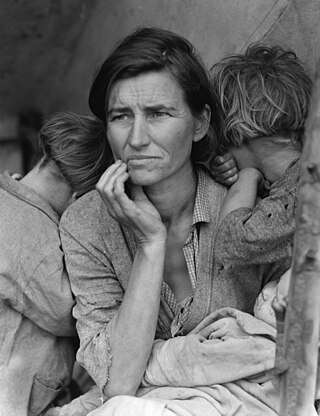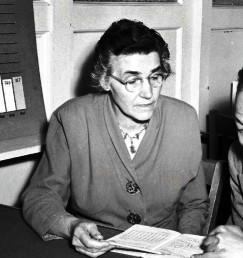
The Grapes of Wrath is an American realist novel written by John Steinbeck and published in 1939. The book won the National Book Award and Pulitzer Prize for fiction, and it was cited prominently when Steinbeck was awarded the Nobel Prize in 1962.

The Dust Bowl was the result of a period of severe dust storms that greatly damaged the ecology and agriculture of the American and Canadian prairies during the 1930s. The phenomenon was caused by a combination of natural factors and human-made factors: a failure to apply dryland farming methods to prevent wind erosion, most notably the destruction of the natural topsoil by settlers in the region. The drought came in three waves: 1934, 1936, and 1939–1940, but some regions of the High Plains experienced drought conditions for as long as eight years.

Arvin is a city in Kern County, California. Arvin is located 15 miles (24 km) southeast of Bakersfield, at an elevation of 449 feet (137 m). As of the 2010 census, the population was 19,304, up from 12,956 at the 2000 census.

Weedpatch is an unincorporated community and census-designated place (CDP) in Kern County, California, United States. Weedpatch is 10 miles (16 km) south-southeast of Bakersfield. It is considered to be one of the poorest areas in Kern County. As of the 2010 census it had a population of 2,658.

An Okie is a person identified with the state of Oklahoma, or their descendants. This connection may be residential, historical or cultural. For most Okies, several of these connections exist and are collectively the source of their being Oklahoman. While not an official demographic used or recognized by the United States Census Bureau, Okies, due to various factors, have developed their own distinct culture within larger social groupings both akin to and separate from Midwestern and Southern influences. Included are their own dialect, music, and Indigenous-derived folklore.

The San Joaquin Valley is the southern half of California's Central Valley, an area drained by the San Joaquin River. Praised as a breadbasket, the San Joaquin Valley is a major source of food, producing a significant part of California's agricultural output.

The Farm Security Administration (FSA) was a New Deal agency created in 1937 to combat rural poverty during the Great Depression in the United States. It succeeded the Resettlement Administration (1935–1937).

A pea-picker is a derogatory reference to poor, migrant workers during the Great Depression. These people were unskilled, poorly educated workers, employable only in menial jobs, such as harvesting crops and, as such, received poor wages for working long hours under dreadful conditions. Some of these people were photographed by Dorothea Lange.

The Resettlement Administration (RA) was a New Deal U.S. federal agency created May 1, 1935. It relocated struggling urban and rural families to communities planned by the federal government. On September 1, 1937, it was succeeded by the Farm Security Administration.

State Route 184, locally known as Weedpatch Highway, is a state highway in the U.S. state of California. Located in Kern County, it runs from the intersection of SR 223 and Wheeler Ridge Road near Arvin north to SR 178 in Bakersfield. It is mainly a 2-lane conventional highway, expanding to four lanes in Lamont and Bakersfield. The highway serves local agricultural land south of Bakersfield.

The Grapes of Wrath is a 1940 American drama film directed by John Ford. It was based on John Steinbeck's 1939 Pulitzer Prize-winning novel of the same name. The screenplay was written by Nunnally Johnson and the executive producer was Darryl F. Zanuck.

State Route 223, locally known as Bear Mountain Boulevard, is a state highway in the U.S. state of California that runs west to east through the agricultural land south of Bakersfield in Kern County. Running from Interstate 5 (I-5) to State Route 58 near the city of Arvin, it also intersects with State Route 99 near Greenfield. SR 223 forms a truck route for transporting goods to the three main corridors in the area, I-5, SR 58 and SR 99, without having to drive through Bakersfield.

Dust Bowl Ballads is an album by American folk singer Woody Guthrie. It was released by Victor Records, in 1940. All the songs on the album deal with the Dust Bowl and its effects on the country and its people. It is considered to be one of the first concept albums. It was Guthrie's first commercial recording and the most successful album of his career.

Arvin High School is located in Arvin, California, United States and is part of the Kern High School District.

The California Dream is the psychological motivation to gain fast wealth or fame in a new land. Some argue that, as a result of the California Gold Rush after 1849, California's name became indelibly connected with the Gold Rush, and fast success in a new world became known as the "California Dream", while others claim this concept did not emerge until the 1960s. California was perceived as a place of new beginnings, where great wealth could reward hard work and good luck. The notion inspired the idea of an American Dream. California was seen as a lucky place, a land of opportunity and good fortune. It was a powerful belief, underlying many of the accomplishments of the state, and equally potent when threatened.

The California agricultural strikes of 1933 were a series of strikes by mostly Mexican and Filipino agricultural workers throughout the San Joaquin Valley. More than 47,500 workers were involved in the wave of approximately 30 strikes from 1931 to 1941. Twenty-four of the strikes, involving 37,500 union members, were led by the Cannery and Agricultural Workers' Industrial Union (CAWIU). The strikes are grouped together because most of them were organized by the CAWIU. Strike actions began in August among cherry, grape, peach, pear, sugar beet, and tomato workers, and culminated in a number of strikes against cotton growers in the San Joaquin Valley in October. The cotton strikes involved the largest number of workers. Sources vary as to numbers involved in the cotton strikes, with some sources claiming 18,000 workers and others just 12,000 workers, 80% of whom were Mexican.

The Forty Acres, located in Delano, California, was the first headquarters of the United Farm Workers labor union. The union acquired the site of the compound in 1966, and the buildings were built in the ensuing years. The first building constructed on the property was a service station built in 1967, and several smaller service buildings were built soon afterward. The main building on the property, the Mission Revival styled Reuther Hall, was built from 1968 to 1969; the hall was named for United Auto Workers organizer Roy Reuther. A health care clinic and a retirement village were added to the property in the early 1970s.

The Harvest Gypsies, by John Steinbeck, is a series of feature-story articles written on commission for The San Francisco News about the lives and times of migrant workers in California's Central Valley. Published daily from October 5 to 12, 1936, Steinbeck explores and explains the hardships and triumphs of American migrant workers during the Great Depression, tracing their paths and the stories of their lives and travels from one crop harvest to the next crop harvest as they eked out a stark existence as temporary farmhands.

Myrnie Ade Gifford (1892–1966) was an American medical physician. She was the first to identify that San Joaquin Valley Fever was the primary stage of coccidioidomycosis.

Whose Names Are Unknown is an American novel by Sanora Babb, written in the 1930s but not published until 2004. It centers on members of a High Plains farm family during the Great Depression as they endure the poverty inflicted by drought and the Dust Bowl; they ultimately flee to California in hopes of building a better life but encounter a new set of hardships.



























